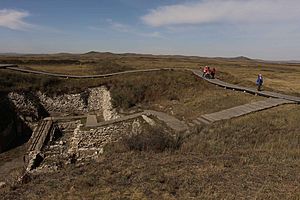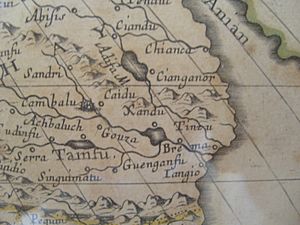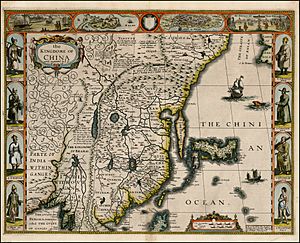Shangdu facts for kids
| UNESCO World Heritage Site | |
|---|---|

Ruins of Shangdu
|
|
| Location | Shangdu Town, Zhenglan Banner, Inner Mongolia, China |
| Criteria | Cultural: ii, iii, iv, vi |
| Inscription | 2020 (44th Session) |
| Area | 25,131.27 ha |
| Buffer zone | 150,721.96 ha |
| Shangdu | |||||||||
|---|---|---|---|---|---|---|---|---|---|
| Chinese | 上都 | ||||||||
| Hanyu Pinyin | Shàngdū | ||||||||
| Literal meaning | Upper Capital | ||||||||
|
|||||||||


Shangdu (Chinese: 上都; literally "Upper Capital"), also known as Xanadu ( Mongolian: Šandu), was a very important city in ancient China. It served as the summer capital for the Yuan dynasty. This dynasty ruled the huge Mongol Empire.
The city was built by Kublai Khan, a famous Mongol leader. He later moved his main capital to Zhōngdū, which was renamed Khanbaliq. This city is known today as Beijing. After that, Shangdu became his special summer home. It is located in what is now Zhenglan Banner, in Inner Mongolia.
A famous traveler from Venice, Italy, named Marco Polo, visited Shangdu in 1275. He wrote about the city, which made it famous in Europe. In 1369, the Ming dynasty army, led by Zhu Yuanzhang, took over Shangdu. The city was later destroyed.
Much later, in 1797, stories about Shangdu inspired a famous poem. The English poet Samuel Taylor Coleridge wrote Kubla Khan after reading about the city.
Contents
What was Shangdu like?
Shangdu was about 350 kilometers (217 miles) north of Beijing. It was also about 28 kilometers (17 miles) northwest of the modern town of Duolun. The city was built in a rough square shape. Its sides were about 2.2 kilometers (1.4 miles) long.
Inside this "outer city," there was an "inner city." This inner city was also a square, with sides about 1.4 kilometers (0.9 miles) long. In the southeast part of the inner city was the palace. This was where Kublai Khan stayed during the summer. The palace area was about 550 meters (1,800 feet) on each side. It was about 40% the size of the famous Forbidden City in Beijing.
The city was first called Kaiping (开平, Kāipíng), which means "open and flat." A Chinese architect named Liu Bingzhong designed it between 1252 and 1256. He made sure the city's buildings looked very Chinese. In 1264, Kublai Khan changed its name to Shangdu.
At its busiest time, over 100,000 people lived within its walls. But in 1369, the Ming dynasty army attacked Shangdu. They burned the city, and its name went back to Kaiping. The last Yuan emperor, Toghun Temür, ran away. The city was then left empty for hundreds of years.
In 1872, a British visitor named Steven Bushell saw the site. He said there were still parts of temples, marble blocks, and tiles there. But by the 1990s, these old pieces were gone. People from the nearby town of Dolon Nor likely used them to build their own homes. You can still see some of these old artworks in the walls of buildings in Dolon Nor.
Today, only ruins remain. You can see grassy mounds where the city walls once stood. Since 2002, people have been working to restore and protect the site. In June 2012, Shangdu was named a World Heritage Site. This means it's a very important place that needs to be protected for everyone.
Marco Polo's Visit (1278)
The famous Italian explorer Marco Polo is thought to have visited Shangdu around 1275. He wrote about his travels around 1298–99. Here's what he said about the city:
Marco Polo described a beautiful marble palace in Shangdu. Its rooms were covered in gold and painted with pictures of people, animals, birds, trees, and flowers. He said the artwork was so amazing it made you happy just to look at it.
Around this palace, there was a wall that enclosed a huge park, about 16 miles (26 km) around. Inside the park, there were fountains, rivers, and streams. There were also lovely meadows with all kinds of wild animals. Kublai Khan kept these animals to feed his hunting birds, like gerfalcons and other hawks. He had more than 200 gerfalcons alone!
The Khan would visit his birds every week. Sometimes, he would ride through the park with a leopard on his horse. If he saw an animal he liked, he would let the leopard chase it. The captured animal would then be given to feed his hawks. He did this for fun.
Marco Polo also described another palace in the park, built in a charming wood. This palace was made of cane (a type of strong reed). It was covered in gold and beautifully decorated inside. It stood on golden, shiny columns. Each column had a golden dragon wrapped around it, with its tail on the column and its head holding up the roof.
The roof was also made of canes, covered with a strong, waterproof coating. These canes were very thick (about 3 palms, or 23 cm) and long (10 to 15 paces, or 7.6 to 11.4 meters). They were split to make hollow tiles for the roof. These cane tiles were nailed down so the wind wouldn't blow them away. The whole palace was built from these canes.
What was amazing about this cane palace was that it could be taken apart and put back together very quickly. The Emperor could have it moved wherever he wanted. When it was set up, over 200 silk ropes held it steady against strong winds.
Kublai Khan stayed in this park for three months each year: June, July, and August. He liked this place because it was very cool and pleasant. When August 28th arrived, he would leave, and the cane palace would be taken apart.
The Sadness of Toghon Temur (1368)
Toghon Temur Khan, also known as the "Sage Khan," was the last Yuan emperor. In 1368, he lost both his main capital, Daidu (Beijing), and his summer capital, Heibun Shanduu (Kaiping Xanadu). His sadness about this loss is written in many Mongolian history books.
He spoke of his beautiful Daidu, made of jewels, and his "Yellow Steppe of Xanadu," the summer home of past Khans. He called Kaiping Xanadu "cool and pleasant." He was heartbroken to lose Daidu in the year of the "bald red rabbit" (a way of naming the year). He felt like a lonely calf left behind.
He spoke of his "eight-sided white stupa" (a type of Buddhist monument) and his "City of Daidu made of the nine jewels." He remembered how he ruled the great nation from there. He lamented that the "iron stair" of his precious Daidu was broken.
He also remembered the Cane Palace, built by the wise Kublai Khan, where summers were spent peacefully. He felt it was a "deadly mistake" not to have listened to warnings. He cried that he had "lost Kaiping Xanadu entirely – to China." He felt a "bad name" had come upon him, the Sage Khan, for losing these precious cities.
He described Daidu as built with many decorations and Kaiping Xanadu as a place of peaceful relaxation. He felt that by a "hapless error," they were lost to China. He hoped that future wise leaders would understand his loss.
Xanadu in Later Writings
Samuel Purchas (1625)
In 1614, an English clergyman named Samuel Purchas published a book called Purchas his Pilgrimes. It included a short description of Shangdu, based on Marco Polo's earlier writings.
He wrote: "In Xandu did Cublai Can build a stately Pallace, encompassing sixteen miles of plaine ground with a wall, wherein are fertile Meddowes, pleasant Springs, delightfull streames, and all sorts of beasts of chase and game, and in the middest thereof a sumpuous house of pleasure, which may be moved from place to place."
In 1625, Purchas released a bigger version of his book. It had a more detailed description of Shangdu, again from Marco Polo's accounts. It talked about the marble palace, the park with meadows, springs, rivers, and deer. It also mentioned the Khan's hunting birds and leopards. He described the royal house made of gilded and varnished cane, with dragons on the pillars. He noted that this house could be taken apart like a tent and rebuilt.
Samuel Taylor Coleridge (1797)
In 1797, the English poet Samuel Taylor Coleridge was reading about Shangdu in Purchas's book. He fell asleep and had a dream, possibly influenced by medicine he had taken. This dream inspired him to start writing the famous poem called 'Kubla Khan'.
Sadly, Coleridge was interrupted by a visitor, a "person on business from Porlock." Because of this, he forgot much of his dream. But the images of Shangdu that he remembered became one of the most well-known poems in the English language.
Coleridge wrote about how he wrote the poem in 1816. He said he was reading this sentence from Purchas's book: "Here the Khan Kubla commanded a palace to be built, and a stately garden thereunto. And thus ten miles of fertile ground were inclosed with a wall."
He then fell into a deep sleep for about three hours. He felt that he had composed hundreds of lines in his dream without effort. When he woke up, he remembered everything clearly and quickly wrote down the lines we have today. But after the interruption, he could only remember "some eight or ten scattered lines and images."
Coleridge's poem starts like Purchas's description. Then it describes the palace's many beautiful and strange features:
- In Xanadu did Kubla Khan
- A stately pleasure-dome decree:
- Where Alph, the sacred river, ran
- Through caverns measureless to man
- Down to a sunless sea.
- So twice five miles of fertile ground
- With walls and towers were girdled round:
- And there were gardens bright with sinuous rills,
- Where blossomed many an incense-bearing tree;
- And here were forests ancient as the hills,
- Enfolding sunny spots of greenery. (lines 1–11)
Xanadu in Space
In 2006, a large area on Saturn's moon Titan was named Xanadu by the International Astronomical Union (IAU). This was a nod to Coleridge's poem. Scientists became very interested in Titan's Xanadu because radar images showed it looked a lot like Earth. It had flowing rivers (but of methane and ethane, not water), mountains (made of ice, not rock), and sand dunes.
Xanadu in Popular Culture
Because of Coleridge's poem, Xanadu became a symbol for amazing beauty and wealth.
- It was the name of Charles Foster Kane's huge estate in the famous movie Citizen Kane.
- It was also the name of Mandrake the Magician's retreat in the old comic strip.
- The villain Xanatos in the Gargoyles TV series had an upstate retreat named after it.
- The 1980 movie Xanadu, starring Gene Kelly and Olivia Newton-John, was named after the poem. This movie also led to the popular song "Xanadu" by Electric Light Orchestra and Newton-John.
- In the novel Timequake by Kurt Vonnegut, Xanadu is a retreat for writers.
- Ray Bradbury wrote a short story called "A Miracle of Rare Device" (1962), which was later made into a TV episode.
- In Xanadu is a 1989 travel book by William Dalrymple.
- The song "Behind the Groove" by Teena Marie (1980) mentions Xanadu.
- The UK pop/rock group Dave Dee, Dozy, Beaky, Mick & Tich had a number one hit in 1968 with "The Legend of Xanadu".
- The Canadian rock band Rush has a song called "Xanadu" on their 1977 album A Farewell to Kings.
- Frankie Goes to Hollywood referred to the poem in the title track of their debut album Welcome to the Pleasuredome.
- The German metal band Blind Guardian mentions Xanadu and building a "pleasure-dome" in their 2015 song "Sacred Mind."
- In the Japanese series Shakugan no Shana, Xanadu is a paradise.
- In the Otherland novels by Tad Williams, a character visits a virtual Xanadu.
- Xanadu is also an alternate name for the utopian city of Tralla-La in the Scrooge McDuck Disney comic books. In one story, it's revealed that Genghis Khan hid his empire's treasure there.
- The city name is also used for a popular 1980s video game called Xanadu: Dragonslayer II.
See also
 In Spanish: Xanadú para niños
In Spanish: Xanadú para niños

